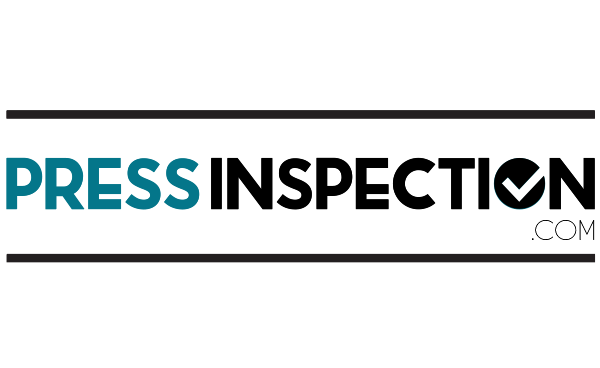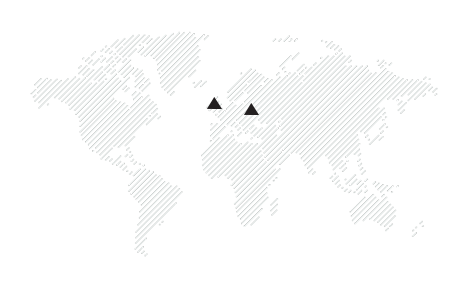Since our project is dedicated to sheetfed printing machines, we just have to tell you about the most interesting models that left a mark on the printing industry.
Do you remember this machine? I’m sure you do.
I would call Adast Romayor the real father of private printing after the collapse of the Soviet bloc.
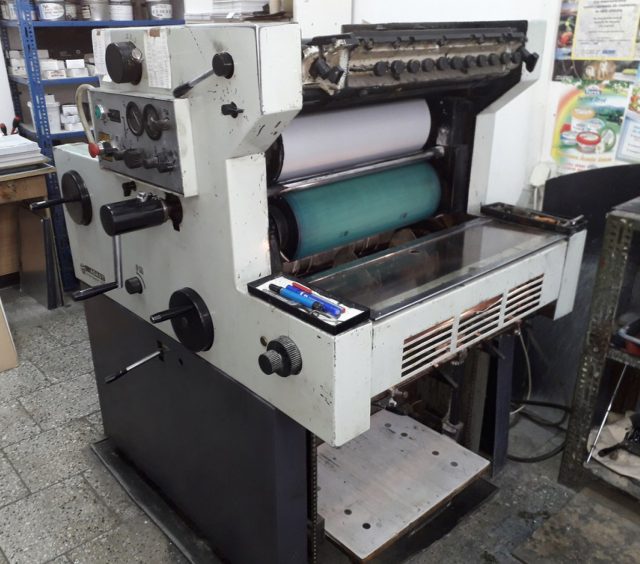 So, Romayor is a famous series of sheetfed offset printing machines. The Czech company Adast was producing it for more than 30 years without significant changes.
So, Romayor is a famous series of sheetfed offset printing machines. The Czech company Adast was producing it for more than 30 years without significant changes.
As I said, these presses were popular in Eastern Europe among small and medium-sized printers due to their reliability, ease of operation and affordable price.
In the heyday of the printing industry in the early 90s, there probably wasn’t a single printing company that didn’t start its business by buying a second-hand Romayor and Dominant. It was easy to get the little machine down in the basement to start earning in a few days without too much investment. A printer who could print full-colour products on the Romajor was able to get a good salary and was literally worth his weight in gold.
History of the model
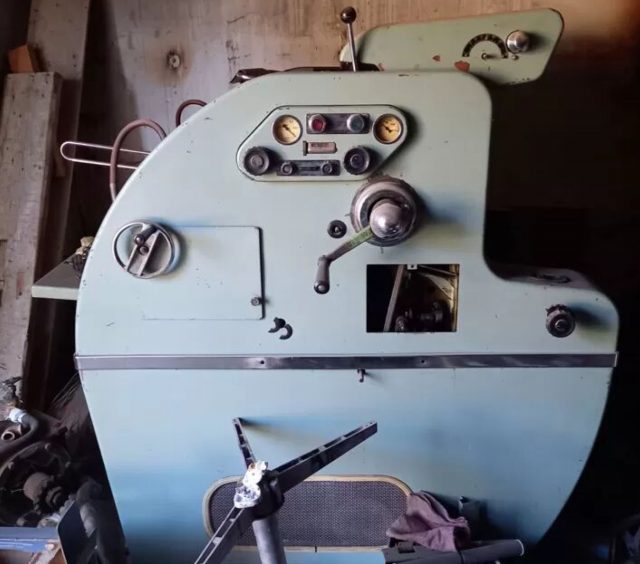 The production of Adast Romayor machines began in the 1960s and were in production until production closed in 1997. The first Romayor II is now at the level of museum rarity: it was produced from 1960 to 1965, and 2965 units were produced. But the most famous Romajor was the next one, the 313 or its later version, the 314, which used perforated plates.
The production of Adast Romayor machines began in the 1960s and were in production until production closed in 1997. The first Romayor II is now at the level of museum rarity: it was produced from 1960 to 1965, and 2965 units were produced. But the most famous Romajor was the next one, the 313 or its later version, the 314, which used perforated plates.
Despite its simplicity, working on this machine required some skill. It was not easy to set up the dampening system with felted felts correctly. The neighbouring pressure roller had to press the ‘sock’ to remove excess moisture. Modern printers have no idea how difficult it was to adjust the correct squeegee. In addition, orthophosphoric acid used to etch the plates, could irritate the printer’s hands.
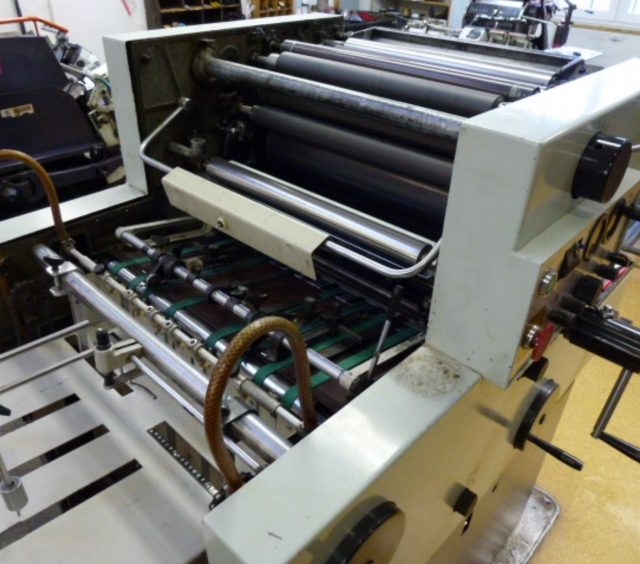 However, this printing machine differed from the small format presses of other manufacturers, such as AB Dick or Ryobi, in one very important feature that made it popular. It was one of the few simple machines on the market with a pull-type side-lay gauge. This allowed a good grip on the sheet and a fairly accurate positioning of the sheet width.
However, this printing machine differed from the small format presses of other manufacturers, such as AB Dick or Ryobi, in one very important feature that made it popular. It was one of the few simple machines on the market with a pull-type side-lay gauge. This allowed a good grip on the sheet and a fairly accurate positioning of the sheet width.
Competitors preferred to install a push type system on their entry level machines. This system only worked well on heavy papers. A thin sheet could spring off the side lay. It was difficult to align it on the short table of the feeder. Only in Heidelberg machines – KORS, KORD, GTO – the pushing side-lay gauge coped well with thin paper, but this solution was patented.
How the machine became the father of private printing
In the 90s, after the closure of all state research institutes, a wave of second-hand Romayors literally flooded the market. Entrepreneurs were eager to buy this simple machine as they found demand for printing business cards, booklets and even colour products. Although the Romayor was very cheap, it wasn’t that bad at all. It was easy to repair, most spare parts were available and cheap, and some things in general were easy to reproduce at the local mechanic shop.
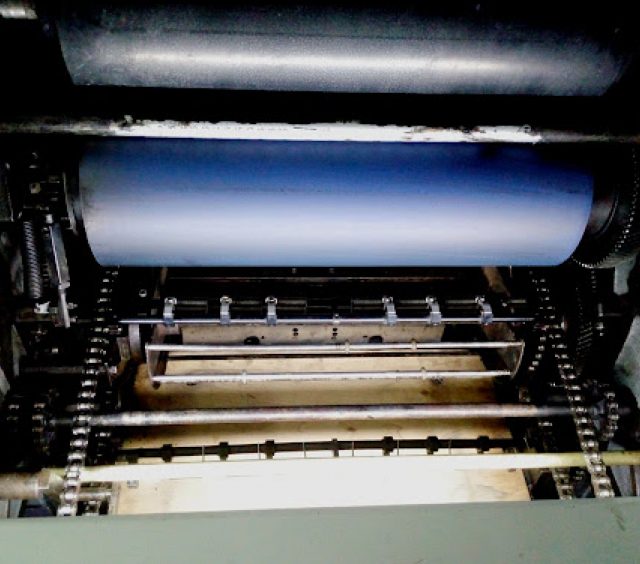 The cheapness of the machine caused a lot of shortcomings, which the owners tried to fight with as best they could. The machine used a perforated plate. This meant that the photographer who produced the plate had no tolerance for error in exposing the plate. On the press you could move the plate only longitudinally or circumferentially. Diagonal register was out of the question in Romayor. Actually, it was not necessary for simple printing works, for which the machine was conceived. But some printing houses managed to print even jobs 4+4 ! And in the 90s it was possible to sell it profitably.
The cheapness of the machine caused a lot of shortcomings, which the owners tried to fight with as best they could. The machine used a perforated plate. This meant that the photographer who produced the plate had no tolerance for error in exposing the plate. On the press you could move the plate only longitudinally or circumferentially. Diagonal register was out of the question in Romayor. Actually, it was not necessary for simple printing works, for which the machine was conceived. But some printing houses managed to print even jobs 4+4 ! And in the 90s it was possible to sell it profitably.
I can write a separate book about modifications of this machine by skilled workers. Due to the lack of money to buy a machine made in Germany or Japan, local craftsmen managed to replace the perforated plate fixing bar with a quick-clamping one. They fought as best they could with the dampening system: they replaced felt rollers with rubber ones. They also put antistatic devices on the feeder. It was a real age of inventions.
While printers in Western Europe had the option of buying machines from renowned manufacturers, printers in Eastern Europe had no choice. As a result, given the amazingly low price of the Czech printing machine, as well as low wages, you could find the in literally any printing house in the former USSR. However, in 1997 the Adast company went bankrupt, but the story of Romayors did not end there.
Modifications
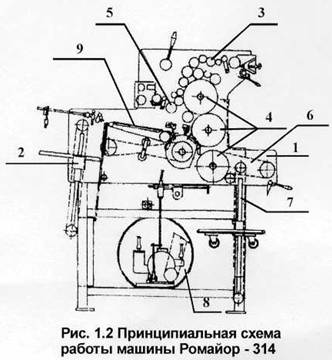 Printers of the 90’s remember well these modifications:
Printers of the 90’s remember well these modifications:
- Adast Romayor 313 – the basic model with a single printing unit
- Adast Romayor 314 – an advanced model with an automatic paper feed system and improved sheet registration system. This model was the most widespread, but by the early 90s, when machines from other manufacturers began to enter the market, it had already become obsolete.
- Adast Romayor 315 was a redesigned machine with more modern solutions to make it more popular in the central European market. This modification has a digital display. Safety at the printer’s work fits to the GS standards. The ergonomics of the printer’s workstation radically improved. After all, the main and undeniable advantage of Romayor is the price of only 19 – 20 thousand EUR. On the new machine it was possible to install either classical dampening unit of Molleton type or VARN-KOMPAC dampening system. The noisy and not always reliable Czech compressor replaced by a Becker device.
- A multi-colour modification Adast Romayor 314-5 that was never put into production. It was a kind of hybrid – a model with five printing sections, allowing to print five colours in one run.
The sunset of a legend
However, time passed, prices for printing products were falling, and wages were rising. More modern versions gradually replaced single-colour machines. But good old presses are still available on sale. For 400-500 euros, you can find one that is still alive.
Despite the bankruptcy of Adast in 1997, Romayor 315s from the early 2000s are still on the market. Polly took over the production, and Adast retained the manufacturing and sale of spare parts for the earlier machines.
The Adast Romayor was an important part of the Adast range of printing machines and left a significant mark on the printing industry with its high reliability, surprising simplicity and affordability. It is a truly legendary machine, fondly remembered by many print professionals.
Technical parameters of the Adast Romayor 314 :
Maximum sheet size: 360×500 mm
Minimum sheet size: 155×210 mm
Maximum print size: 331×488 mm
Minimal paper size: 135×180 mm
Dimensions of printing plate: 368x490x0,15 mm
Blanket size: 410х496×1,9 mm
Paper stack height on the self stacker: 400mm
Paper stack height on the receiving table: 400mm
Maximum working speed: 7500 sheets per hour
Machine dimensions, mm: 1120 (width) x1400 (length) x1490 (height)
Power consumption: 1,1 kW
Weight, kg: 720
